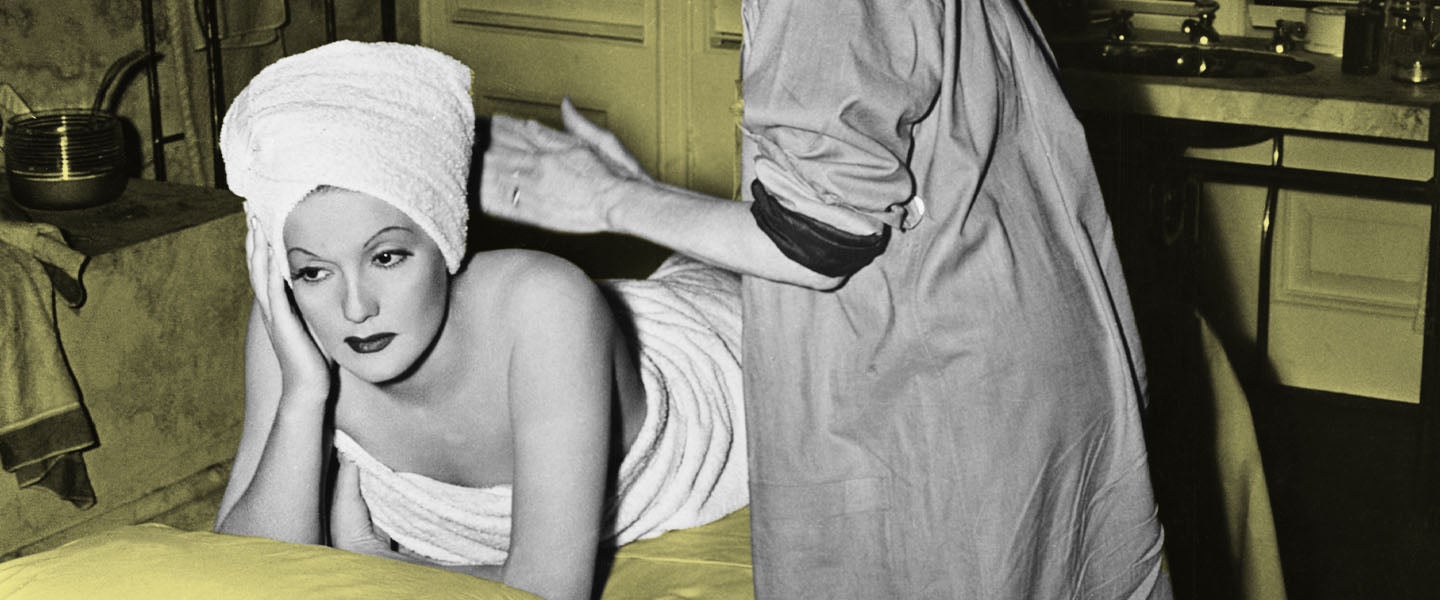For some reason, many, many, many people tend to overestimate their ability to give a great massage. And while it may seem like what constitutes a good or bad massage is simply a matter of taste, it really isn’t. “People are usually just rubbing oil or lotion on someone when they offer another person a massage,” says Helen, a masseuse trained in Swedish and shiatsu massage who works at The Now, a chain of massage boutiques in L.A. “But anyone can put oil or lotion on you.”
“I always have to train my partners how to therapeutically touch my body if they ever want to ‘give me a massage,’” adds Lena, a neuro-muscular therapy and myofascial release specialist who sees private clients in L.A. “I’m very specific and direct in my instructions, which is probably annoying and not sexy in any way.”
The only upside to this dearth of good amateur masseuses? There’s a lot of room for improvement — as well as an army of excellent bodywork practitioners from which to learn (a la Helen and Lena). Speaking of Helen and Lena, here’s some of their advice on how to improve your “healing-hand” game…
Don’t Give Massages In Bed
Partner massage is often thought about as a prelude to sex, but neither the massage — nor the sex — has to happen in bed. In fact, according to Helen, massaging your partner in bed is counterproductive. “All the pressure will be absorbed by the mattress,” she explains. “Instead, create a little area for massage directly on the floor. Lay down a couple blankets and maybe a pillow or two. Light candles, dim the lights. Establishing the energy of the space could ultimately make the experience more enjoyable.”
Trust Yourself (But Only to a Point)
“Touch is our first sense to develop, and most of us have these instinctive habits of grabbing someone’s shoulders or neck,” Helen says. “If people trusted their inner feelings more, they’d be better able to sense what areas of a person’s body need touch.” Still, she concedes, everybody’s body craves different things, so sticking to one massage “script” won’t necessarily work. As such, she advises, “Ask questions about where they feel tension or where they’d like release.”
Breathe Super Loudly
Okay, not so loudly that you freak the recipient out, but loud enough to encourage them to let go too. “Breathing audibly helps subconsciously assure them it’s safe to deeply relax and plug into the experience. It’s a conduit to being in the present moment,” Helen explains. “If you still sense they aren’t breathing deeply as you touch them, you can remind them to take deep breaths.”
You might also encourage them to send their breath to whatever area is being worked on, as a means to further clear that energetic space.
Get Under Their Skin
“Skin is at play during a massage, but it’s really just a way of getting to the tissue through compression,” Helen says. “This tissue is what matters, not the skin. Compression recirculates the blood.”
To perform compression techniques on your partner, Helen recommends using the heel of your palm in a chosen area and pressing down for at least 10 seconds at a time. Each area needs to be compressed for about this long, so remain patient.
Similarly, Lena says it’s crucial to be aware of one’s fascia: “Fascia is a web of connective tissues, made up of collagen and elastin fibers. Fascia resides everywhere in the body, interwoven throughout all our systems, providing a framework for our human form and functions, under the deepest layer of our skin, covering our bones, wrapping our individual muscles, enclosing and separating muscles into groups, encasing our organs and nerves. It can become stiff, sticky, bunched up or twisted, which in turn can exert a force of tension and pull on the entire structure of the body. I work to release these pulls by applying firm, steady pressure in order to sink slowly down into deeper layers of muscle tissue and break up adhesions in the fascia and soften the muscle.”
“Sometimes stretching accompanies the direct pressure to assist in separating muscles that may have become stuck to one another, to pin down and break up an adhesion in muscle tissue or to reset the resting position of a muscle,” she continues. “Sometimes grasping and kneading individual muscle is utilized to soften tissues. All of this work is done without oils or lotions so that all the layers of connective tissue can be addressed and nothing is forced. Essentially, I’m working with the tissues as opposed to forcing my will on them.”
Focus on The Feet
“People love foot massages; they’re sort of the classic way to help a partner relax,” Helen says. “For an upgrade, incorporate essential oils. For feet, I recommend sandalwood, rose and other earthy smells.”
Although it seems pretty obvious, Lena emphasizes how unaware we are of the fact that our feet are responsible for our entire structure. “Everyone should roll their feet out with a tennis ball or lacrosse ball,” she explains. “Our entire structure is built upon the structure of our feet, so it’s important to keep our feet mobile and healthy.”
When In Doubt, Seek Professional Help
No matter how great you become, consider gifting your partner a professional treatment every now and again, too. “Our structure — or the way we hold our body — is dictated by neural pathways or ‘muscle memory,’” says Lena. “These neural pathways are formed by the way we learned how to walk or how our parents taught us how to hold our bodies. They’re also formed by any physical accidents we’ve experienced — e.g., spraining an ankle, stubbing a toe, falling off a bike, etc. Anything that required our bodies to adjust our movement in some compensatory way, which usually leads to a domino effect of zig-zag patterns throughout our structure.
“The value of regular treatments is that we can consistently work on rewiring the body to combat these potential aggravating holding patterns so that our bodies have better options for movement and posture.”
Which again, is why sometimes the best thing you can do is arrange for an expert touch.

